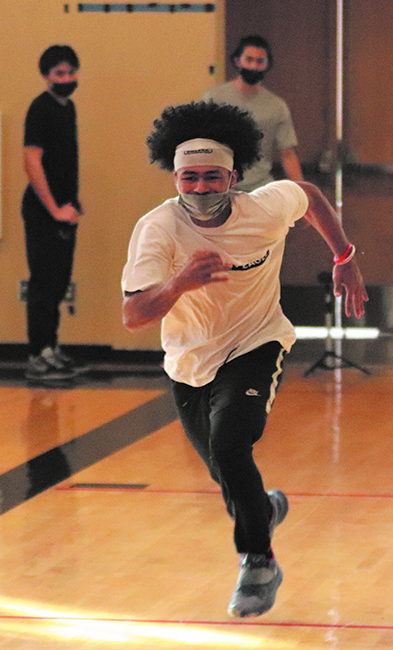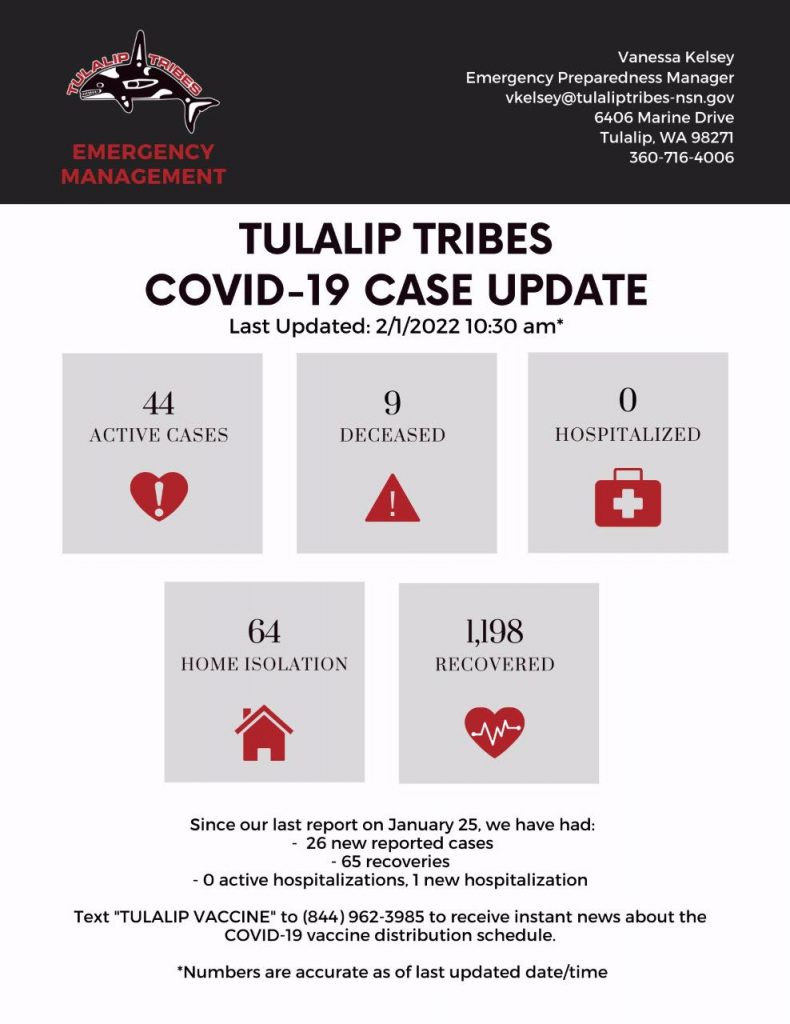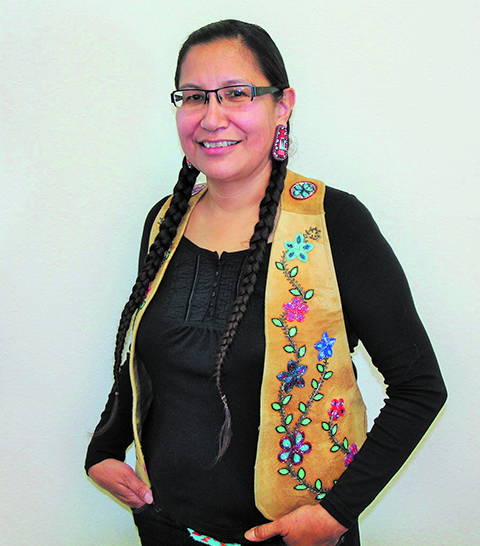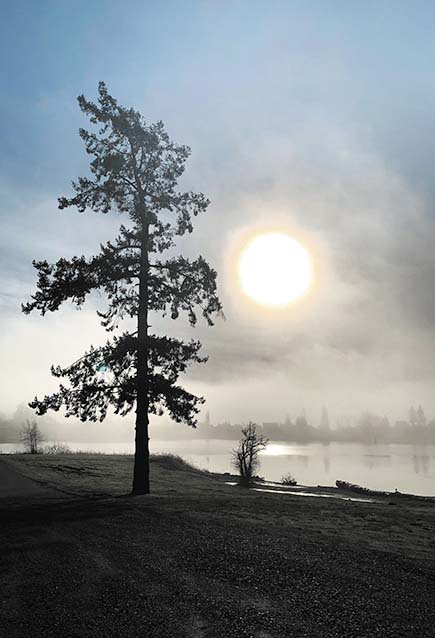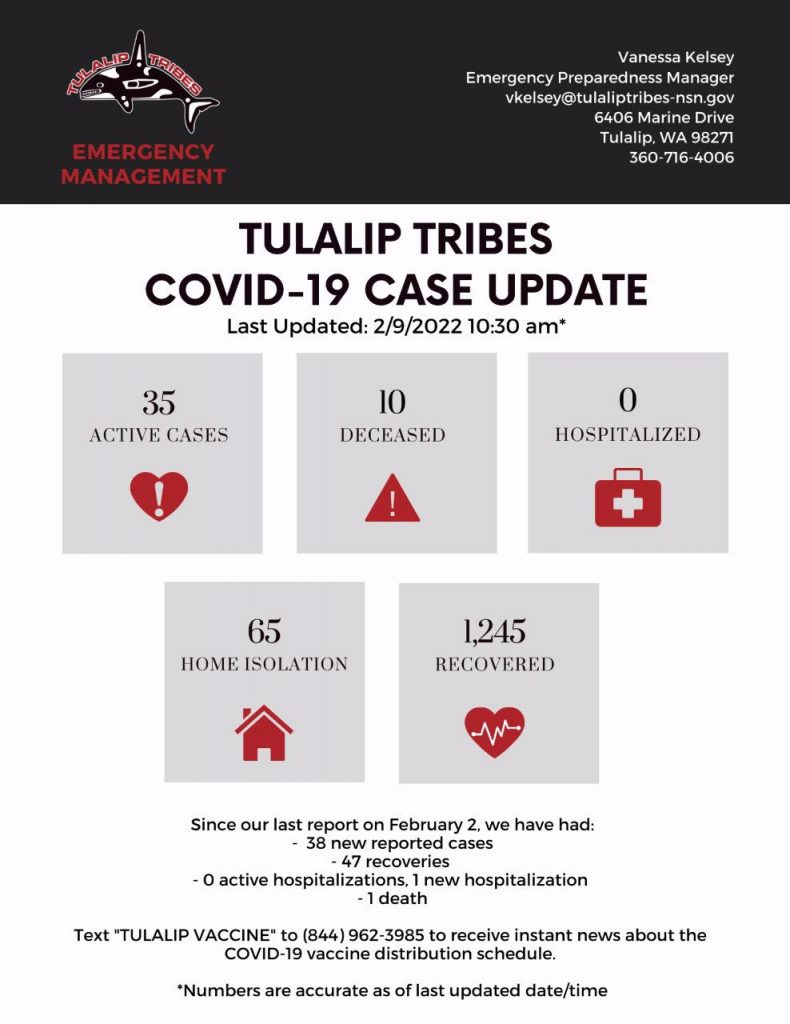
Category: Tulalip News
Tulalip athletes train like the pros
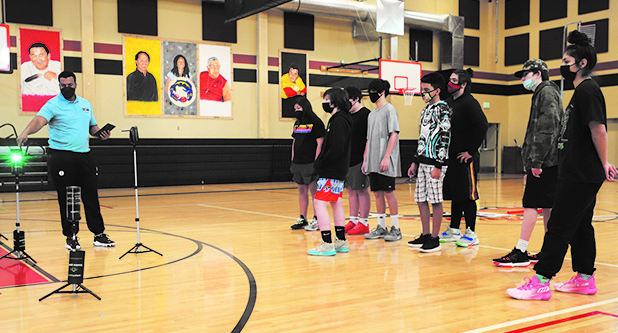
By Micheal Rios, Tulalip News
There are many things Tulalip is known for. Depending upon who is asked, the responses may vary widely. However, within Snohomish County coaching circles a common response is raw athleticism.
Indeed, for generations now, Tulalip has churned out athletes who have showcased an uncanny ability to learn and compete in sports at a high level. Whether it be at the beginning stages at the Boys and Girls Club or YMCA, middle school intermediate stage or varsity quality at local high schools, Tulalip is well-represented across the sporting spectrum.
As our proud athletes continue to push the boundaries of what’s possible for a simple Rez kid, like those currently fulfilling their dreams to play collegiate sports, it’s critical for the next generation to receive access to the newest training technology and latest performance-based guidance.
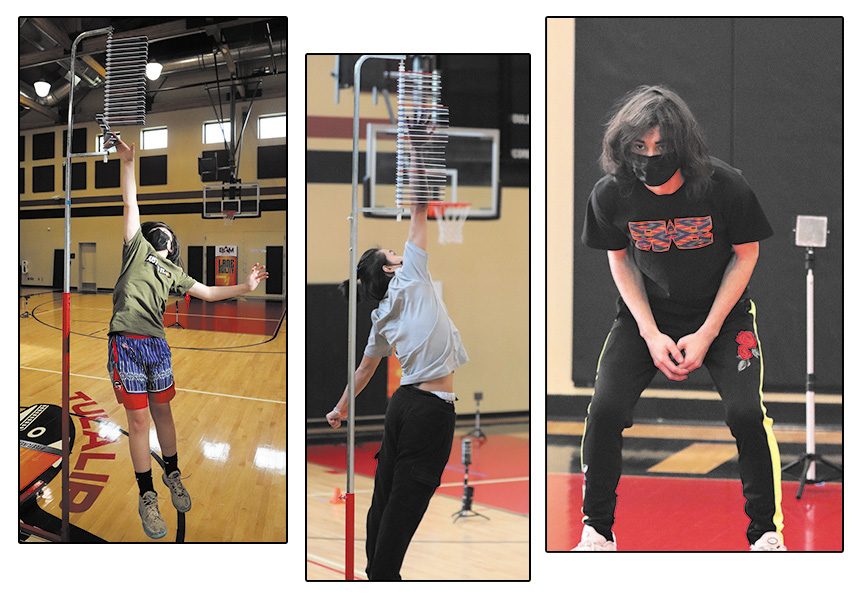
Analytics and data is quickly becoming the preferred method for evaluating college prospects and professional athletes. In keeping up with the data-driven times, husband/wife duo DeShawn and Sharmane Joseph created a first-of-its-kind partnership to bring cutting-edge athletic assessors Basic Athletic Measurement (BAM) to Tulalip.
“Moving in real-time, many Tribes, educational systems, and business institutions throughout the world are using data and analytics to make informed decisions about any number of things. Why not, then, use data and analytics to assess our children’s athletic needs and abilities? This way we can showcase their talents and give them something real from top level trainers to motivate, inspire, and change their path, one kid at a time,” explained DeShawn.
The Joseph’s Reservations Without Borders program and BAM hosted a modified skills camp in the friendly confines of the Tulalip Youth Center on Saturday, January 29. The skills being tested? That raw athleticism Tulalip is known for.
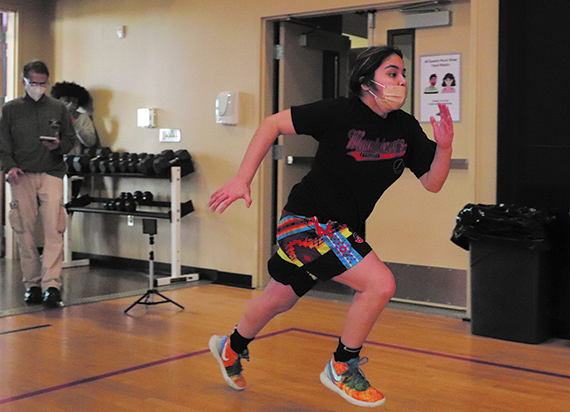
Athletic assessment typically relies on stop watches, manual data collection, and non-standardized testing protocols. Due to bias and inconsistency, comparing and benchmarking an athlete’s performance has historically been a subjective measure. BAM has revolutionized the process with remote sensors, motion tracking lasers, and other SmartSpeed tech wizardry. BAM’s staff and methodology have been stamped with approval by the NBA, ADIDAS, Under Armour, EuroCamp, and power 5 college conferences such as the PAC12 and the BIG10.
“We were invited to come to Tulalip and present our service we offer to athletes around the world,” said BAM founder Brett Brungardt. He has nearly thrity years of experience as a strength and conditioning coach for the Dallas Mavericks and University of Washington basketball teams. “We brought this technology to the NBA fourteen-years-ago and since then its been utilized for twenty-two different sports. Our design assesses each athlete and provides them with a foundation to build from. This way they can workout or train in a manner that they know is making them faster, improving agility, increasing power…basically improving all the components necessary for becoming a better athlete.”
After the preregistered Tulalip athletes showed up at the Youth Center, joined by a few excited day of participants, things quickly got going on the freshly waxed gymnasium hardwood. Brett and his team gave the aspiring sport superstars a quick orientation and immediately got to warm-ups. Everyone hit the lines and participated in a 15-minute group warm-up session to adequately stretch and prepare for the training to come.
The traditional basketball court area had been reconfigured into five testing zones, each with a unique function and it’s own set of challenges. The group of kids were split up into groups and rotated through each zone, being allowed a practice try and then two scored attempts. A nearly identical set up as professional ballplayers at the annual NBA Combine.
Each testing zone provided a key measurement that when used as a whole can determine a participant’s overall athleticism. The zones were as follows:
- Vertical Jump. Evaluates the ability to exert a maximal force in as short a time as possible within vertical distance depending upon sport specifics.
- Sprint. Evaluation to determine acceleration, maximum speed and endurance speed. Sprint time can be performed over varying distances, depending upon sport specifics.
- Reaction Shuttle. Evaluates the ability to show how quick and effective decisions are made and actions initiated, plus the brief interval of time it takes to react to an external stimulus.
- Broad Jump. Athlete starts within 15 feet of the Vertec. It is a running start vertical jump. Measurement is similar to the vertical jump, but also includes athlete’s ability to coordinate and incorporate strength and power with reach.
- Agility. Valuation measures the ability to make quick changes of direction while moving at speed and the ability to move quickly and change directions.
Every basketball player knows that major bragging rights go to the player with the most hops, and the easiest way to determine that is the though an official vertical jump test. One by one the athletes got into position, buckled their knees for an added boost and then leaped skyward, extending their fingers as far as possible. After the competitive jumping session, the day’s vertical jump crown went to 17-year-old Tommy Nguyen.
“I knew I could jump high, but not that high! A thirty-seven inch vert is definitely low key bragging rights,” said Tommy to his fellow Marysville-Pilchuck teammates.
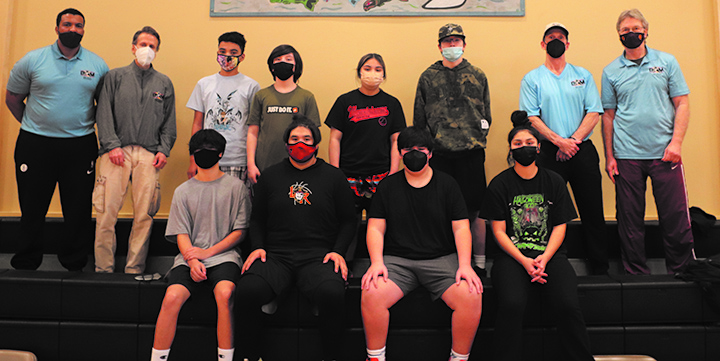
During the agility and reaction shuttle drills, it become apparent to the athletes that pure speed and power could be outdone by light, nimble feet and a lightning fast reaction. It was in these events that 13-year-old Mayleah Madera shined brightest.
“My favorite sports are basketball, softball and volleyball. I can’t choose just one, I love them all,” beamed Mayleah after her days testing session. “Today was a lot of fun and different than anything I’d ever done before. The coaches told me that by being light on my feet and continuing to develop better foot work that I’ll be an overall better athlete for all my sports. Also, it was really cool to outscore the boys on some activities.”
New and developing technologies like BAM’s athletic assessment system make it possible to standardize a player’s performance level. Giving them not only an athletic GPS to track their progress, but to recognize areas in need of growth as well. For families who dedicate endless time and financial resources to their child’s dreams, these assessment systems validate a commitment to athletic excellence.
Emphasizing the event’s unique nature, BAM staff made sure the young athletes recognized how special they were by remarking multiple times this was the first group of Native Americans to ever test their athleticism under the BAM system. Something DeShawn and his wife are proud of, as they hope to test thousands of Native kids throughout the country with this latest partnership.

“They got to witness the beautiful athleticism come out of our kids. The showcasing talent we’ve always seen in our communities came to life today, in front of real professionals who were able to track the data we need to move our kids forward in a good way,” reflected DeShawn after the day’s session concluded. “With this technology, our kids and athletes can gauge themselves and know exactly which parts of their training they need to focus on to improve their overall skills.
“With this BAM partnership we hope to achieve the same outcomes in Indian Country that the professional institutions are getting from their athletes – the inspirational improvements and the amazing stories,” he continued. “I’m hoping over a 5-10 year span we can test over 10,000 Native American kids in all of their communities throughout the United States and Canada.”
DeShawn added a special thank you is in order to the Tulalip Board of Directors for believing in his vision for our athletes and the Youth Center for providing an amazing facility and lunches for all the participants.
February 5, 2022 syəcəb
Please follow the link to download the February 5, 2022 issue of the syəcəb
Is your goal to stop smoking? Tulalip Community Health is here for you

By Shaelyn Hood, Tulalip News
Like most goals, people have the mindset to change habits in their life. Whether it’s to negative a habit or improve upon one. Throughout the years, one common goal amongst Americans, and one of the hardest to stop, is trying to stop smoking.
According to the FDA, smoking cigarettes accounts for 480,000 premature deaths per year. Even though the knowledge about the negative effects of smoking is widely known by Americans, still around 34 million Americans smoke cigarettes today and smoking remains the leading cause of preventable disease and death in the United States. “In 2015, nearly 70 percent of current adult smokers in the United States said they wanted to quit. In 2018, about 55 percent of adult smokers had made a quit attempt in the past year, but only about 8 percent were successful in quitting for 6-12 months.”
If you break down the components of cigarettes, the most harmful ingredients are nicotine, carbon monoxide, and tar. Not to mention, over 600 other deathly chemicals including but not limited to, benzene, arsenic, and formaldehyde. These chemicals lead to issues like cancer, heart disease, stroke, lung diseases, diabetes, and chronic obstructive pulmonary disease (COPD). The active and most addictive ingredient is the nicotine, which inevitably makes quitting that much harder.
Much like cigarettes, what is becoming more of a concern in society is the rise in use of e-cigarettes. Even though they do contain different ingredients, and cause different health issues, e-cigarettes can be equally as devasting to your health. According to monthly newsletter from the National Institutes of Health, and U.S. Department of Health and Human Services, “A new survey found an alarming rise in the number of American teens who tried vaping last year. The study suggests that vaping may be driving an increase in nicotine use for teens”, and “Exposure to nicotine during youth can lead to addiction and cause long-term harm to brain development. The vapor can also contain toxins (including ones that cause cancer) and tiny particles that are harmful when breathed in.”
One could argue that the use of tobacco is a part of tribal culture. Traditional tobacco used to be harvested and used by Native Americans for ceremonial and medicinal purposes. It used to hold cultural and spiritual importance, and was offered when asking for help, guidance, or protection. In many teachings, the smoke that burned from the tobacco would carry thoughts and prayers to the spirit world or to the Creator. However, these traditions used tobacco in its purest form, and its ingredients differ widely from the products that tobacco is paired with today. Along with that, the use of cigarettes and e-cigarettes don’t hold the traditional values that smoking tobacco once had, but rather are used on a more recreational basis.
Like many other health issues, the Tulalip Community Health Department is invested in the wellbeing of tribal members. One of these efforts includes the 12-week, Smoking Cessation program. The purpose of the program is to provide a sanctuary for tribal members and any Snohomish County residents and assist them as they attempt to tackle quitting smoking. They do this by providing education and resources for community members on replacing addictive behaviors with health and wellness. This is accomplished through prevention activities, counseling (one-on-one, and group), and support for ongoing prevention (such as smoking cessation and use reduction). Additionally, they provide various nicotine replacement therapy like patches, gum, and lozenges.
When speaking with Seilavena Williams, prevention coordinator for the program, she said “what makes it unique is that we intertwine with myself, and two nurses who have had the tobacco specialist training. Also, that it is free. Most clinics or services don’t offer those products for free. But we do training, provide education and support, but also, we supply you the products as well.”
The value of the training that these representatives have is that they have a better understanding of someone’s journey. Williams said, “We know it takes time and understanding and patience with an individual. When they want to take this next step of wanting to quit, sometimes it doesn’t happen right away. Sometimes it takes a few times, but we are there supporting them throughout their journey.”
Currently with the Covid-19 pandemic, and the respiratory issues that follow the virus, it becomes a crucial time to stop smoking. Studies have shown that people that have predisposed illnesses and health concerns are more likely to have higher complications when contracting Covid-19. In a pandemic time, with the assistance of the Smoking Cessation Program, you have the ability to try and take control of your health again.
If you or someone you know is needing help quitting cigarettes or e-cigarettes, and need more information about the Smoking Cessation program, please contact Seilavena Williams at 360-716-5662.
Tulalip Tribes COVID-19 Case Update, Feb 1
Introducing the Maternal Infant Health Program
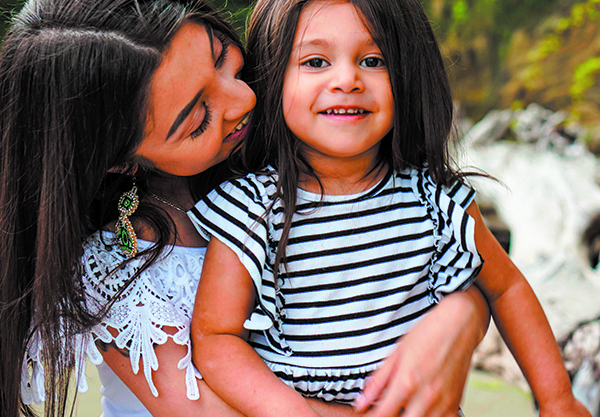
By Micheal Rios, Tulalip News
It takes a village to raise a child is a powerful proverb that means an entire community of people must provide for and interact positively with a child so that it may grow in a safe, healthy, and culturally vibrant environment. On paper it sounds perfect, right? But among the concrete jungles and techno-filled landscapes of modern America, its increasingly difficult to find examples of this proverb being fulfilled.
For expectant mothers and those with babies, not having a village or support system of encouraging individuals around during such a vulnerable time can be devastating. On the Tulalip Reservation, there’s a new program striving to provide that critical support for our life givers. The Maternal Infant Health Program (MIHP) seeks to improve birth outcomes within the Tulalip Tribal community. The program’s vision is to provide education and support resources that create an environment of empowered, educated and supported mothers and children.
To better explain the program’s purpose and services, it’s coordinator, Community Health nurse Morgan Peterson, sat down with Tulalip News for a thorough overview. A Rosebud Sioux tribal member, she’s lived locally to Tulalip most of her life. After receiving her nursing degree and working in OB-GYN offices throughout the area, Morgan has spent the last twelve years dedicated to prenatal health in Tulalip.
What is the purpose of the Maternal Infant Health Program?
“The ultimate goal is for our families to feel empowered and to ensure they are having a birth experience that is positive. For young, first time moms this may mean education and providing a safe space to ask questions or seek guidance. For a mom adding to her family, this may mean improving birth outcomes and healing from past traumas so that mom and baby are treated with the best care available.
A major part of MIHP includes building resiliency. We want our life givers to be confident in all aspects of motherhood. I’m passionate about meeting my clients wherever they are in life, and walking beside them on their journey to self-determination.”
Does this include coordination of home births?
“Yes, it does. More and more moms are choosing to give birth in the comfort of their own home or a setting of their choosing outside of a hospital. We’ll help our life givers achieve their birthing goals, whether it’s by coordinating a hospital birth or navigating the home birth process. There’s different options available to our families, such as birthing centers, too, which we can tour together if they’re interested.”
Are MIHP services for individual mothers only, or can family units be included?
“Having a child in a warm, nurturing environment may mean having your family or even grandparents involved. We understand a lot of Native homes are multi-generational. We are more than willing to work with our Native family units, however they may look, to assist mothers be in the best position possible. If you’re living with your parents, grandparents, or other relations we want to make sure your immediate support system is educated to yours and baby’s needs.”
Breaking cycles of abuse and healing from generational traumas are common concepts to Native parents. Are these processes you help with?
“Our history with boarding schools and the foster care system has resulted in whole generations of traumatized families. If not addressed and healed, then that trauma gets passed on from one generation to the next, which we often see. I understand the intricacies of this process because my grandma was in a boarding school. She was forcibly taken from her family in Pine Ridge and never mothered. She grew up with the nuns, was beaten and stripped of her language. My grandma was never taught to be motherly or maternal, so when she raised her kids, she provided for them, but was never motherly. That’s to say she wasn’t loving. That led to my mom wanting to be better, and to do so she had to learn to be loving because she wasn’t taught that by my grandma.
We understand everyone is trying to be better than the generation before, but it’s often difficult to admit these traumas that need to be healed so we don’t pass them on to our kids. That’s where we can help by offering services to learn how to change parenting styles in order for our children to be nurtured and feel loved.”
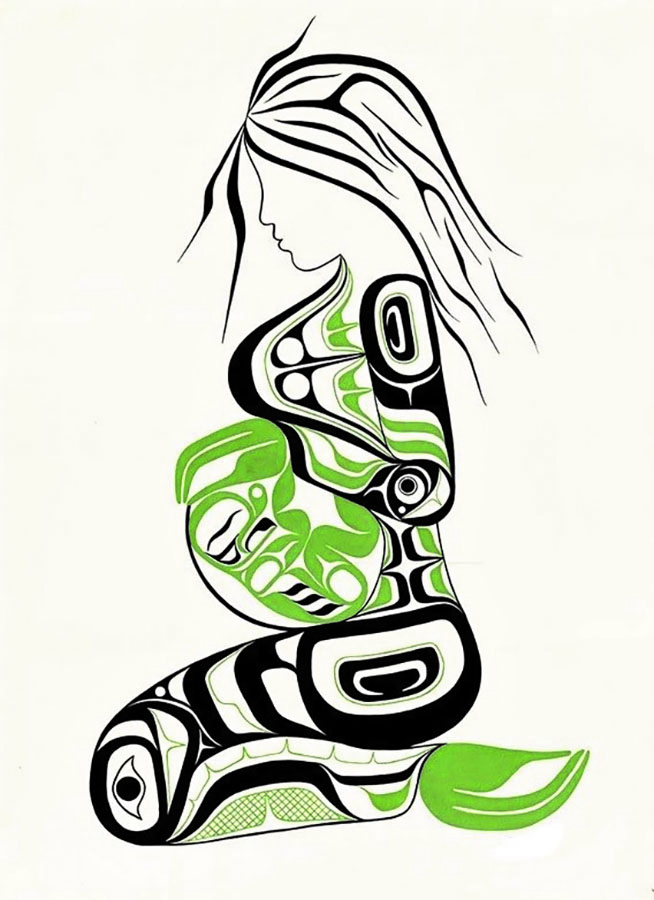
The concept of ‘birth outcome’ is new. You mentioned your goal to improve them, but what does a negative birth outcome mean?
“A common negative outcome is described by those who have experienced racism and traumas by medical providers or the medical community at large. Those who have felt judged or were treated as addicts, and those who experienced a general lack of cultural competency by their providers, all lead to negative birth outcomes.
Another common one is unnecessary CPS reports or accusations of bad parenting that lead new parents or parents with multiple kids to avoid routine doctor visits and check-ups. Teen moms can feel shunned and stereotyped in ways that deter them from receiving the critical information and services they need.
We seek to improve birth outcomes by providing education and support resources that create a positive environment where mothers and their children feel supported. This includes recommending medical providers who are familiar with Native American culture and are sensitive to the unique aspects and issues of Tulalip families.”
Can you share one of your favorite improved birth outcome experiences?
“Sure. One of my favorites is about a mom who found out she was pregnant while in jail. She contacted me after she was got out and was living in a halfway house while going to treatment…all while having a new born baby. I was familiar with their family and knew where the traumas come from. Their parents had massive addiction. Assisting this mom build the resiliency to stay strong, find the right support system for her, and maintain a journey of sobriety was life changing for her and her children. That was a couple years ago when she called me, and she’s still sober to this day. Her journey and love for her children inspired one of her parents to get clean as well. This is an inspirational story for some and motivational for others. It lets them know what’s possible.”
For an expectant mother or mom with a new born, what does the MIHP startup process look like?
“It starts with either a simple phone call or in-person visit, whichever they prefer. We would discuss their pregnancy, how they are doing, and what services they need. Each mom is unique as is what she may need help with. Our help ranges from maternal and infant health assessments; pregnancy and parenting support; infant health and development education; breastfeeding and nutrition support; and referrals/registration to community resources based on their needs. Just to name a few. We have so many possible services and ways of helping our new moms.”
The Maternal Infant Health Program is an evidence-based, culturally-tailored home visiting partnership designed to assist, support, and empower expectant moms (those currently pregnant) and moms with children under 3-years-old. If you or a loved one meets these criteria and could benefit from hearing all of the amazing details this program can offer, please contact Morgan directly via email mpeterson@tulaliptribes-nsn.gov or call/text 360-926-5978.
January 29, 2022 syəcəb
Please follow the link to download the January 29, 2022 issue of the syəcəb
January 22, 2022 syəcəb
Please follow the link to download the January 22, 2022 issue of the syəcəb
Insight from Idle No More co-founder Sylvia McAdam

By Micheal Rios, Tulalip News
Sylvia McAdam (Saysewahum) has garnered respect from around the globe as a cofounder of the international movement Idle No More. Hailing from the Treaty 6 lands of modern day Canada, she’s travelled the continent to support countless First Nations and Native American tribes in their efforts to defend and protect sacred lands, waters, and animals.
Sylvia is a citizen of the Cree Nation and proudly holds a Juris Doctorate (LL.B) from the University of Saskatchewan and a Bachelor’s of Human Justice (B.H.J) from the University of Regina. She is a recipient of the Carol Geller Human Rights Award, Foreign Policy’s Top 100 Global Thinkers Award, 2014 Global Citizen Award, and has received several eagle feathers from Indigenous communities that she holds dear. A law professor at the University of Windsor, Sylvia is routinely asked to speak on her experiences defending Indigenous rights and participating in Indigenous-led protest movements.
Idle No More started in November 2012, among Treaty People in Manitoba, Saskatchewan, and Alberta protesting the Canadian government’s dismantling of environmental protection laws, endangering First Nations who live on the land. Born out of face-to-face organizing and popular education, but fluent in social media and new technologies, Idle No More has connected the most remote reserves to each other, to urbanized Indigenous people, and to the non-Indigenous population.*
Led by women, and with a call for refounded nation-to-nation relations based on mutual respect, Idle No More rapidly grew into an inclusive, continent-wide network of urban and rural Indigenous working hand in hand with non-Indigenous allies to build a movement for Indigenous rights and the protection of land, water, and sky.
Because colonization has dramatically caused the heartbreaking loss of Indigenous languages, customs and traditional lifeways, Sylvia uses the oral tradition of her people to share her dream to revitalize Indigenous nationhood. It is Sylvia’s dream, shared by many Indigenous peoples, that freedom, liberation and self-determination will lead Indigenous peoples away from the pain of genocide and colonialism.
Following a riveting presentation at the World Issues Forum, she honored See-Yaht-Sub staff with a sit-down interview to discuss several issues that are of utmost importance to Indigenous peoples and communities.
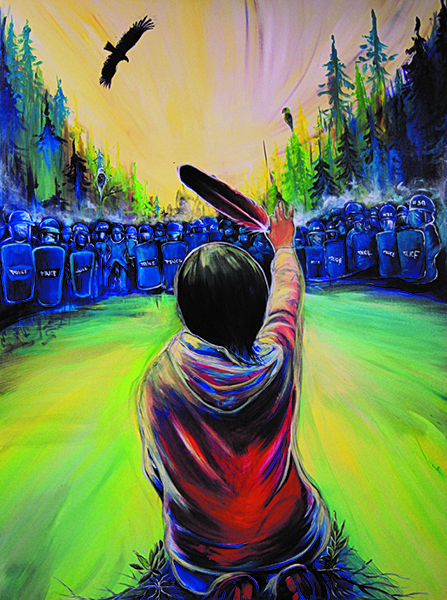
SYS: During your presentation you mentioned as Indigenous peoples we shouldn’t identify as an ‘environmentalist’ or ‘activist’, but instead view ourselves as defenders of our homeland. Why is that?
“When you begin to identify as an environmentalist or activist there’s a fear that arises because those terms can be associated with economic terrorists. The fear is rooted in the belief that environmentalism and activism affect the economy. That’s part of it, the other part is activism and environmentalism infers that there is no inherent connection to the land; you just show up and protest. However, when it comes to Indigenous people doing this kind of work, their connection, attention, and investment to the land is much different. Our history is written on the land, our ancestors are buried here, that land is our home. So we are defending and protecting our home. Being defenders of our homeland shifts the thinking, as it should, because our connection with the land is unique.”
SYS: Viewing ourselves as defenders of our homeland also unites us, regardless of citizenship as Native Americans or First Nations people. As defenders of our homeland we become a common people with a set of common goals, right?
“Absolutely. When you are born you are born not only as a human being, you are born into lands. When we go home we have a very clear set of lands that we are born into and we have a responsibility and obligation to protect those lands. That’s what I continue to do every day and that’s why I tell people, ‘when you know your lands you will know your relatives.’ I’m not just talking about the human relatives, I’m talking about the land, the plants, and all the animals, the flyers, the crawlers and the swimmers. Those are all our relatives and right now they have no agency to defend and protect themselves. That’s where we need to step up because the forces that threaten our land and humanity are very identifiable right now. Those forces are the extractive corporations that are going into our lands, almost in a frenzy, to take the very things we need to sustain us.”
SYS: Some of the forces that continue to threaten Native culture and Indigenous identity are more covert than others. You mentioned the term ‘ethnocide’ earlier. Can you explain what ‘ethnocide’ is?
“We speak about genocide, but people forget about ethnocide. Ethnocide is the death of the way of being of people; the things that we need to carry us on as a people. Ethnocide is the taking of our trees, the taking of our water, and
the taking of our plants. What then do we have to carry our ceremonies on? The ceremonies are pivotal and integral in who we are as a people. If you could not have trees to make your canoes, what then? If there are no trees then there are no forests to harvest from. If the waters and oceans are poisoned and you can no longer perform your ceremonies, then what happens to your songs and the language? How does your culture live on? You lose who you are as a people. That’s ethnocide.”

He explains, “Going to my first rally in 2012, I needed a poster to bring along. Knowing that the fist and feather with its image of strength and spirituality was quickly becoming the symbol of the movement, I thought it would be fitting if I created one in the formline style indicative of the west coast. I quickly drew up this image at my dining room table and then put it on my Facebook page and it suddenly went viral. Soon, this image appeared on poster boards, buttons, t-shirts, stickers and banners. My feeling was that I wanted this image to go out into the world and find a life of its own. It did.”
SYS: The idea of disenrollment based upon blood quantum is gaining traction amongst many tribes. It’s based on a system of thought not of our own, but instead is passed down from colonization. What are your thoughts on disenrollment?
“It’s so unfortunate because it seems we’re always in the realm of inadequacy. We’re always inadequate; its either we have too much culture or not enough culture. We’re always in that measure of inadequacy. Ultimately, we can turn to our ancestors to see we never throw away our relatives. We never throw them away, even the ones we have come to adopt. It’s against our culture and against our natural laws as Indigenous peoples. At the end of the day, if you can demonstrate and show to me where your lands and your relatives are, then doesn’t that speak for itself? Every child, every original peoples’ child is born into lands. They have an inherent right to protect and defend those lands. No human can take that away from them.
If you are dis-enrolling children, then you are taking away their inherent obligation and jurisdiction into the lands they are born into. No human being has that right. It’s against our laws to do that. For every Indigenous child born it’s the duty of the parents to make sure that child is connected into the land, so that when they grow up they will defend and protect their relatives who don’t have agency to defend themselves.”
SYS: What astounds you most when you look back at all you’ve experienced and achieved over the past decade with Idle No More?
The amazing courage of grass-roots people when they set their minds to things. That’s what blows me away. The courage and determination of so many individuals who unite and come together for a common goal is what drives Idle No More. On a global scale, we got a message from the Amazon, from the original peoples there, and they told us they were trying to stop the development of a dam. While defending their homeland they were opposed by paramilitary brought in to keep them away from the dam site. On one occasion they were standing there with their spears and bow and arrows chanting ‘Idle No More!’ while the paramilitary pointed their guns at them. They told us Idle No More was their battle cry.
So when I start to feel discouraged or overwhelmed I remind myself of these stories to remember I’m not alone. I have to be a voice for those who can’t speak for themselves and continue this work. If I don’t, then what am I going to tell my grandchildren when they ask me, ‘what did you do to protect and defend our culture and homeland?’ I want to be able to tell them I did everything that I could. That’s why I’m here.”
*source: http://www.idlenomore.ca
Tsunami & fog advisories over MLK weekend
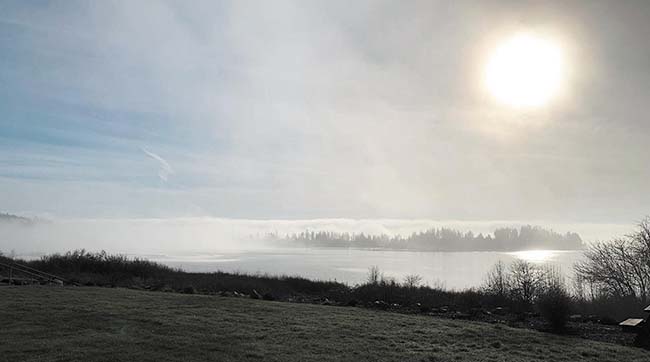
By Kalvin Valdillez, Tulalip News
Following the two-week holiday snow storm that led us into the new year, the Pacific Northwest’s forecast has consisted of nearly all the different types of weather since. From our typical overcast and rainy days to clear sunny skies, Washington state residents have experienced just about every type of precipitation imaginable as well as felt the various degrees in temperature, ranging from below freezing to as warm as the low 50’s.
On an early evening last week, many people were compelled to reach for their smart phones and open their camera apps to snap a shot of the sky, which was a scene filled with gorgeous and vibrant colors of pink, purple, blue and golden hues. Multiple areas throughout the state also dealt with extreme flooding as this winter’s snowfall began to melt after steadily compiling for several days in a row.
Starting out, 2022 has already seen snow, rain, hail and sunshine, not to mention cloudy and windy days. And over the three-day weekend, in which we take to time to honor the legacy of Dr. Martin Luther King, local meteorologists predicted that we were set to have our first encounter with some morning fog throughout the Puget Sound region this year.
Although the weather specialists did predict fog in the forecast, they also thought it would only occur in the early hours of Saturday January 15, and sunshine would prevail for the rest of the long weekend. As we know, however, that was not the case as heavy condensation hung in the air, and coastal communities experienced limited visibility as a dense fog advisory was put into effect, extending through both Sunday and MLK day.
Amidst the fog and the mist, many of us woke to urgent alerts and notifications on Saturday morning, stating that we, along with California, Oregon, B.C., and Alaska, were under a tsunami advisory. The underwater Hunga Tonga-Hunga Ha’api volcano erupted in the South Pacific on the evening of January 14, covering the isles of the Tonga nation with ash and smoke, as reported by CNN. The tsunami waves caused from the volcanic eruption first hit the shores of Tonga, flooding several homes of the island community.
The initial waves were reportedly several feet high and traveled thousands of miles across the Pacific Ocean and eventually reached the Salish Sea on Saturday morning. The National Weather Service warned local residents to stay away from the beaches and coastlines as the tsunami waves arrived, claiming that the waves could be as big as three feet and could potentially drag people out to sea.
At Tulalip, the reservation was covered with a thick layer of fog. It was suggested on Tulalip News Facebook that the fog was brought on because of the volcano eruption and subsequent tsunami waves. But as it turns out, the two bouts of weather, which both called for advisories, were indeed separate.
The eruption did in fact impact the fog. However, an 820-mile-per-hour shockwave traveled nearly 6,000 miles to our local region and actually cleared some of the fog temporarily, and for a moment blue skies and sunshine could be seen in certain areas of the northwest.
The effects of the volcano eruption and tsunami waves have yet to be seen and many are wondering if it will impact the climate, sea-level rise or marine life. Scientists and specialists are still studying the natural phenomenon. And with the recent tsunami threat, many coastal communities are updating their tidal wave and evacuation plans.
With the somewhat extreme and unpredictable weather occurring throughout this winter, it is important to stay up-to-date with the current forecast. Be sure to follow the National Weather Service on your preferred social media platform and set-up a few weather alerts on your phone to be best prepared for whatever weather may come our way.
You can also text STORM to 844-962-3985 to stay up to date on the latest information about storms and emergencies on the Tulalip Reservation.
